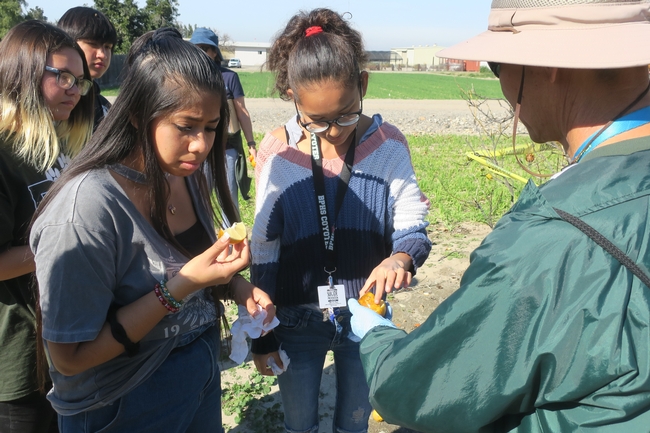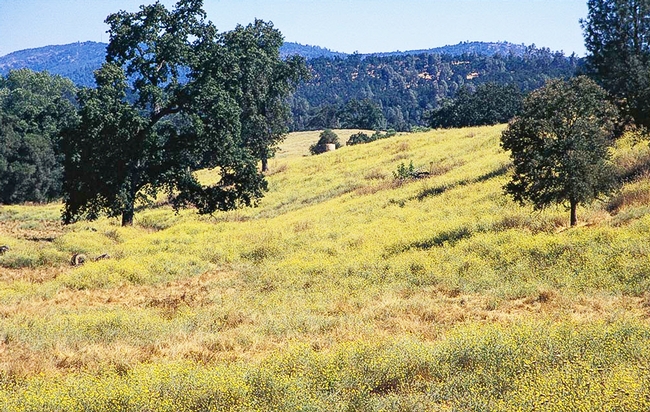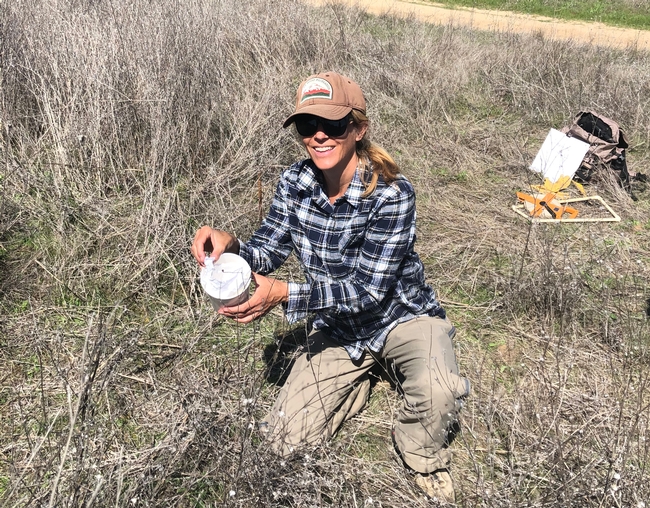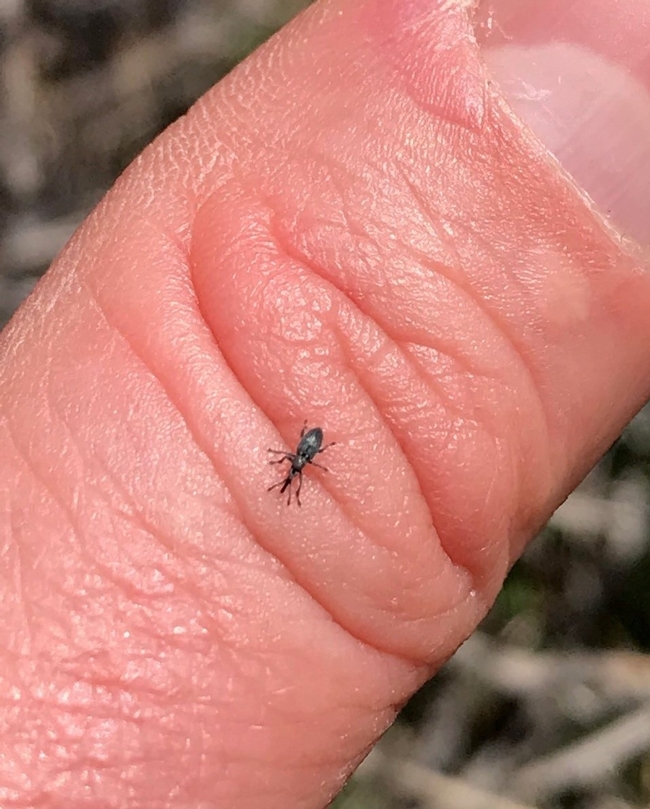Posts Tagged: bureau
Orange County Farm Bureau gift elevates UC programs that inspire youth in agriculture
Commitment of $690,000 supports UC South Coast Research and Extension Center, 4-H programs
During a “GROW Field Day” when 100 high school students enjoyed harvesting and tasting avocados, the Orange County Farm Bureau announced a $690,000 gift to expand University of California-affiliated programs that introduce young people to agricultural careers.
The students from four schools across Southern California participated in the GROW program on May 13 at the UC South Coast Research and Extension Center in Irvine, a UC Agriculture and Natural Resources facility that organizes and hosts these educational programs.
“Part of the mission of Orange County Farm Bureau is to support the development of the next generation of agriculturalists,” said Casey Anderson, executive director of OCFB, in announcing the five-year commitment that will begin in 2023. “Through our partnership with South Coast Research Extension Center and support of Orange County 4-H, we are thrilled to provide opportunities to young people to directly connect with food production and myriad research and career opportunities in agriculture.”
Hundreds of local youth are served every year by Orange County 4-H, a part of a nationwide youth development and education program, administered in California by UC ANR.
“OCFB contributions to our Forever 4-H Endowment will soon provide sustaining funds every year, indefinitely,” said Rita Jakel, Orange County 4-H program coordinator. “And their commitment to our Program Support Fund will help ensure that 4-H will continue to have the capacity to impact the youth of Orange County.”
GROW program introduces youth to agriculture careers
The GROW program, originally conceived by OCFB as a way to make agricultural experiences more accessible to more young people across the region, has engaged over 1,000 students from nine schools – many of them in urban areas where knowledge of agriculture is limited. The program builds on a strong history of collaboration between OCFB and South Coast REC, dating back to the early 2000s.
“UC ANR and South Coast Research and Extension Center are grateful for the trust the Orange County Farm Bureau continues to place in us to not only deliver agricultural education to the people of Orange County, but also to open the eyes of young people to fulfilling careers in agriculture,” said Darren Haver, director of UC South Coast REC.

“To me, it's like a great big outdoor classroom,” said Tammy Majcherek, a South Coast REC community educator specialist who coordinates the GROW program, along with colleague Jason Suppes. “There are so many possibilities of what we can connect to.”
Programs spotlight diversity of agriculture-related fields
Gina Cunningham, a teacher at Westminster High School (part of the Huntington Beach Unified School District), was excited to bring the 20 freshmen in her agricultural biology class to the GROW Day, where they get a glimpse of potential pathways in agriculture that “are not directly farming-related.”
“This gives kids an opportunity to see some things that are available to them that maybe they never have thought of – and there are a lot of things out there that I might not have thought of, either,” said Cunningham, who has degrees in animal science and agricultural education.

Thanks to OCFB's long-term commitment to the program, GROW coordinators Majcherek and Suppes said that in the coming years they would like to bring more students with career aspirations outside of traditional agricultural roles. In particular, they hope to reach out to young people with interests in culinary arts and food service, as well as in technology and engineering, which intersect with food production in the form of drones, robotics and artificial intelligence.
Regardless of their background, however, almost all of the students love harvesting crops from the South Coast REC farm, whether pumpkins, potatoes, or – during the most recent GROW Day – avocados. Majcherek said it's especially rewarding to hear the students talk enthusiastically about older siblings who went to a GROW program and came back with enduring memories – as well as some fresh produce.
“You know it's cool when they're taking selfies with their bounty,” she said.
Community members interested in joining the Orange County Farm Bureau in support of South Coast REC and 4-H programs are encouraged to make a donation on UC ANR's annual Giving Day, which runs from noon to noon on May 19-20.
Officials release new weevil to battle yellow starthistle
In April 2021, scientists released weevils from the Mediterranean region of Europe at the Bureau of Land Management Magnolia Ranch day-use area in El Dorado County to join the battle against yellow starthistle. Yellow starthistle rosette weevil is a newly approved natural enemy of yellow starthistle, which was introduced in California more than 150 years ago and, with no natural enemies in its new location, became one of the state's most harmful weeds, infesting nearly 15 million acres.
In California, yellow starthistle can grow to shoulder height, forming massive, thorny patches that block hiking trails, crowd out native plants and present a wildfire danger. The plant is toxic to horses and its flowers are encircled by inch-long sharp spines that can pierce the eyes of grazing animals.
UC Cooperative Extension has worked for decades with landowners to manage yellow starthistle-invested land.
“Over the years, we have developed effective control strategies for yellow starthistle – including well-timed mowing, grazing, hand pulling, burning, cultivation and herbicide application,” said Scott Oneto, UC Cooperative Extension natural resources advisor in El Dorado County. “But these treatments are rarely implemented on a scale large enough to combat our enormous starthistle infestations.”
Efforts to introduce natural enemies from yellow starthistle's home range began in the 1960s. Several species were released to attack starthistle flower heads. These insects lay eggs, hatch and feed on developing seeds, reducing seed production.
“Although the flower head insects sometimes attack high proportions of flowers, yellow starthistle is a very prolific seed producer with an individual plant producing as much as 100,000 seeds,” Oneto said. “Even if the insects reduce seed production by 50%, that still leaves a lot of seeds.”
The newly introduced yellow starthistle rosette weevil, first collected in Turkey as a prospective biocontrol agent in 1984, attacks the plant at the base. Since 2001, United States Department of Agriculture research entomologist Lincoln Smith has studied the insect at the USDA Agricultural Research Service laboratory in Albany.
“Larvae of the weevil develop and feed inside the root crown during spring, adults emerge in June, and then they spend the rest of the year hiding,” Smith said. “There is only one generation per year, so populations will grow slowly, which will gradually reduce yellow starthistle populations.”
The weevil presents no risk to other plants in California except bachelor's buttons, which is an introduced plant from Europe, but not considered a noxious weed. Successful biological control with the weevil is expected to reduce yellow starthistle, but not completely eliminate the weed.
This was the second release of the beneficial insect in North America. The first release occurred in Solano County in April 2020.
Bureau of Land Management and University of California Cooperative Extension researchers will be monitoring the Magnolia Ranch site intensively over the next several years to determine the rate of rosette weevil reproduction and efficacy at feeding on yellow starthistle.
For more information, see A New Warrior Released in the Battle to Control Yellow Starthistle by Scott Oneto on the UC Weed Science blog.
Farm Bureau voices support for UCCE
Delegates at the California Farm Bureau Federation annual meeting in Monterey last week adopted new policy language in support of UC Cooperative Extension, according to a story in the federation's newspaper AgAlert.
Written by assistant editor Ching Lee, the story outlined the actions taken by delegates representing 53 county farm bureaus. These policies will guide the efforts of farm bureau leadership and staff, the article said.
In light of recent budget reductions to UCCE, the new policy said CFBF supports "an active and evolving" role for Cooperative Extension and that funding for its programs must be adequate to meet the needs of those it serves.
In other actions, the delegates:
- Reiterated their commitment to new water development
- Strengthened policy to protect agricultural land, specifically with respect to the construction of large-scale solar power facilities on privately owned ag land
- Recognized forestry management challenges caused by wilderness designation
- Reinforced opposition to regulatory fees that are collected on top of taxes or to supplant tax revenue
Additional policies adopted at the meeting addressed the disposal or treatment of ag drainage water, opportunities for high school and community college technical education and training, understanding how the new federal health care law will affect farm families, and changes in laws that impose estate and gift taxes.
UC director receives farm bureau President's Award
The California Farm Bureau Federation presented the director of UC Agriculture and Natural Resources Governmental and External Relations, Steve Nation, with a President's Award last night at its annual meeting in Anaheim, according to an article published on the AgAlert Web site today.
"Steve has worked closely with Farm Bureau leaders and staff to create better opportunities for all of us involved in the business of farming," farm bureau president Doug Mosebar was quoted in the story.
The article, written by Dave Kranz, says Nation began his association with the farm bureau in 1979 as executive director of the California Integrated Remote Sensing System. He joined the state Department of Conservation in 1980, and began working with the university in 1985.
Nation plans to retire at the end of February 2010.

Steve Nation
UC the midwife in birth of California Farm Bureau
The California Farm Bureau Federation is marking its 90th anniversary next year with an article in the current issue of AgAlert that traces the organization's origins and provides historical anecdotes. In the article, UC Cooperative Extension gets credit for being the "midwife" when the statewide organization was born in 1919.
Extension was created by the federal government in 1914. Before academic staff would be assigned to a county, the service was required to establish a farm organization to channel information from advisors and specialists to farmers and their families.
A county Farm Bureau representing at least 20 percent of the farmers in the county had to be operating before a farm advisor could be appointed for the county, according to the AgAlert article, written by the publication's executive editor, Steve Adler.
The first California county to qualify was Humboldt, which formed its Farm Bureau in 1913. The following year, Yolo, San Joaquin and San Diego counties founded their Farm Bureaus.
The article quoted a 1917 circular written by the founder of California's Agricultural Extension Service, B.H. Crocheron. Crocheron envisioned the county Farm Bureau acting as "a sort of rural chamber of commerce and ... the guardian of rural affairs. It can take the lead in agitation for good roads, for better schools, and for cheaper methods of buying and selling."
"Perhaps the Farm Bureau can help to buy cheaper and better seeds, can help to boost the local socials, can encourage the faltering school teacher, can get out and talk for good roads--but its first and surest function is to increase the local knowledge of agricultural fact," Adler further quoted Crocheron.
In time it became clear that the Farm Bureau should pursue a broader agenda, according to the article.
"Because the university could not participate in those extra activities, organizers decided to separate the Farm Bureau from the extension service. That was accomplished with the birth of CFBF on Oct. 23, 1919, when its constitution and bylaws were officially adopted," Adler wrote.




